
Tights are a kind of cloth garment, most often sheathing the body from the waist to the toe tips with a tight fit, hence the name. They come in absolute opaque, opaque, sheer and fishnet styles — or a combination, such as the original concept of the American term pantyhose with sheer legs and opaque panty. A variant, toe tights, are tights with individual toes, in the same way toe socks are socks with individual toes.

Mountain biking is a sport of riding bicycles off-road, often over rough terrain, usually using specially designed mountain bikes. Mountain bikes share similarities with other bikes but incorporate features designed to enhance durability and performance in rough terrain, such as air or coil-sprung shocks used as suspension, larger and wider wheels and tires, stronger frame materials, and mechanically or hydraulically actuated disc brakes. Mountain biking can generally be broken down into distinct categories: cross country, trail, all mountain, enduro, downhill and freeride.
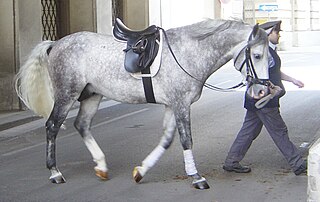
English saddles are used to ride horses in English riding disciplines throughout the world. The discipline is not limited to England, the United Kingdom in general or other English-speaking countries. This style of saddle is used in all of the Olympic and International Federation for Equestrian Sports (FEI) equestrian disciplines, except for the newly approved FEI events of equestrian vaulting and reining. Most designs were specifically developed to allow the horse freedom of movement, whether jumping, running, or moving quickly across rugged, broken country with fences. Unlike the western saddle or Australian Stock Saddle, there is no horn or other design elements that stick out above the main tree of the saddle.

Sidesaddle riding is a form of equestrianism that uses a type of saddle which allows riders, generally female, to sit aside rather than astride an equine. Sitting aside dates back to antiquity and developed in European countries in the Middle Ages as a way for women in skirts to ride a horse in a modest fashion while also wearing fine clothing. It has retained a specialty niche even in the modern world.
Due to the nature of triathlons as a race consisting of multiple sports many pieces of technical equipment have been borrowed from other sports, or developed specifically in an effort to race faster and improve a competitors safety.

Chamois leather is a type of porous leather, traditionally the skin of the chamois, a type of European mountain goat, but today made almost exclusively from the flesh split of a sheepskin.

Longeing or lungeing is a technique for training and exercising horses where the horse travels in a circle around the handler. It is also a critical component of the sport of equestrian vaulting.

A crupper is a piece of tack used on horses and other equids to keep a saddle, harness or other equipment from sliding forward.

Cycling shorts are short, skin-tight garments designed to improve comfort and efficiency while cycling.

Cycling gloves are gloves designed for cycling. They may provide warmth, comfort and protection.
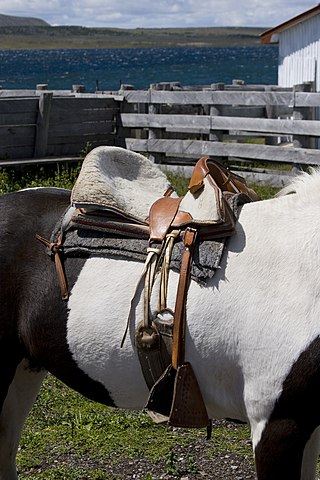
A girth, sometimes called a cinch, is a piece of equipment used to keep the saddle in place on a horse or other animal. It passes under the barrel of the equine, attached to the saddle on both sides by two or three leather straps called billets. Girths are used on Australian and English saddles, while western saddles and many pack saddles have a cinch, which is fastened to the saddle by a single wide leather strap on each side, called a latigo.

Jodhpurs, in their modern form, are tight-fitting trousers to the ankle, where they end in a snug cuff, and are worn primarily for horse riding. The term is also used as slang for a type of short riding boot, also called a paddock boot or a jodhpur boot, because they are worn with jodhpurs.
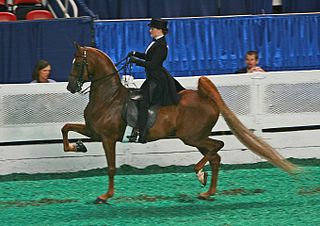
Saddle seat is a style of horse riding within the category of English riding that is designed to show off the high action of certain horse breeds. The style developed into its modern form in the United States, and is also seen in Canada and South Africa. To a much lesser extent, it is ridden with American horse breeds in Europe and Australia.
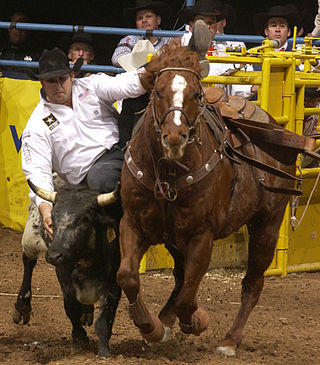
A breastplate is a piece of tack (equipment) used on horses. Its purpose is to keep a saddle from sliding back. It is also a safety feature—if the saddle's girth or billets break, a rider may have enough time to stop the horse and dismount before the saddle slips off the animal's back. The breastplate is used on both English and Western saddles. Western riding involving working cattle use a thicker sturdier style than in English riding or Western riding horse shows. A breastplate is most helpful for horses with large shoulders and a flat ribcage. A breast collar as part of a harness is used to pull a load.

A saddle is a supportive structure for a rider of an animal, fastened to an animal's back by a girth. The most common type is equestrian. However, specialized saddles have been created for oxen, camels and other animals. It is not known precisely when riders first began to use some sort of padding or protection, but a blanket attached by some form of surcingle or girth was probably the first "saddle", followed later by more elaborate padded designs. The solid saddle tree was a later invention, and though early stirrup designs predated the invention of the solid tree, the paired stirrup, which attached to the tree, was the last element of the saddle to reach the basic form that is still used today. Today, modern saddles come in a wide variety of styles, each designed for a specific equestrianism discipline, and require careful fit to both the rider and the horse. Proper saddle care can extend the useful life of a saddle, often for decades. The saddle was a crucial step in the increased use of domesticated animals, during the Classical Era.

A bicycle saddle, sometimes called a bicycle seat, is one of five contact points on an upright bicycle, the others being the two pedals and the two handles on the handlebars. The bicycle saddle has been known as such since the bicycle evolved from the draisine, a forerunner of the bicycle. It performs a similar role as a horse's saddle, not bearing all the weight of the rider as the other contact points also take some of the load.

Bareback riding is a form of horseback riding without a saddle. It requires skill, balance, and coordination, as the rider does not have any equipment to compensate for errors of balance or skill.

A horse harness is a device that connects a horse to a horse-drawn vehicle or another type of load to pull. There are two main designs of horse harness: (1) the breast collar or breaststrap, and (2) the full collar or collar-and-hames.
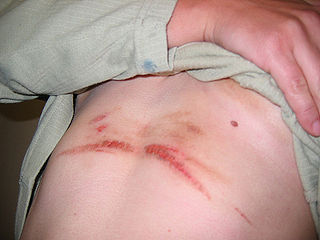
Chafing is an irritation or superficial abrasion of skin caused by friction, moisture or irritating fabric. Prolonged rubbing on the skin may result in skin sting or burn, and development of a mild, red rash or boils; and in severe cases may include swelling, bleeding, or crusting. It often results from body parts that rub against each other or against clothing. It commonly occurs on the inner thighs and buttocks, and nipples, groin, feet, and armpits can also chafe, although there it is less common. Severe chafing is known as friction burn.

A cycling pad, also known as "chamois" or "bikepad" or "Fondello" (Italian), Peau (French) is a protective insert that is applied in cycling shorts with the main purpose of protecting the groin from the friction of constant and prolonged saddle contact. Cycling pads were developed at the beginning of the 1900s and were exclusively made of deer leather up until the 1980s, when technical fabrics were introduced, and allowed for enhanced performance.


















